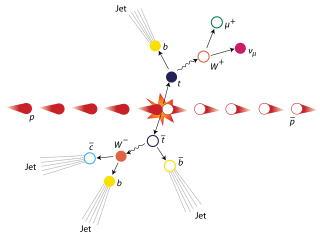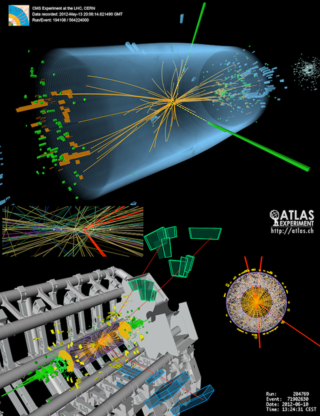
In particle physics, an elementary particle or fundamental particle is a subatomic particle that is not composed of other particles. Particles currently thought to be elementary include electrons, the fundamental fermions, as well as the fundamental bosons, which generally are force particles that mediate interactions among fermions. A particle containing two or more elementary particles is a composite particle.

A gluon is an elementary particle that acts as the exchange particle for the strong force between quarks. It is analogous to the exchange of photons in the electromagnetic force between two charged particles. Gluons bind quarks together, forming hadrons such as protons and neutrons.
In particle physics, a hadron is a composite subatomic particle made of two or more quarks held together by the strong interaction. They are analogous to molecules that are held together by the electric force. Most of the mass of ordinary matter comes from two hadrons: the proton and the neutron, while most of the mass of the protons and neutrons is in turn due to the binding energy of their constituent quarks, due to the strong force.

The top quark, sometimes also referred to as the truth quark, is the most massive of all observed elementary particles. It derives its mass from its coupling to the Higgs Boson. This coupling is very close to unity; in the Standard Model of particle physics, it is the largest (strongest) coupling at the scale of the weak interactions and above. The top quark was discovered in 1995 by the CDF and DØ experiments at Fermilab.
In supersymmetry, the neutralino is a hypothetical particle. In the Minimal Supersymmetric Standard Model (MSSM), a popular model of realization of supersymmetry at a low energy, there are four neutralinos that are fermions and are electrically neutral, the lightest of which is stable in an R-parity conserved scenario of MSSM. They are typically labeled
N͂0
1,
N͂0
2,
N͂0
3 and
N͂0
4 although sometimes is also used when is used to refer to charginos.

The Large Hadron Collider (LHC) is the world's largest and highest-energy particle collider. It was built by the European Organization for Nuclear Research (CERN) between 1998 and 2008 in collaboration with over 10,000 scientists and hundreds of universities and laboratories, as well as more than 100 countries. It lies in a tunnel 27 kilometres (17 mi) in circumference and as deep as 175 metres (574 ft) beneath the France–Switzerland border near Geneva.
In particle physics, the W and Z bosons are vector bosons that are together known as the weak bosons or more generally as the intermediate vector bosons. These elementary particles mediate the weak interaction; the respective symbols are
W+
,
W−
, and
Z0
. The
W±
bosons have either a positive or negative electric charge of 1 elementary charge and are each other's antiparticles. The
Z0
boson is electrically neutral and is its own antiparticle. The three particles each have a spin of 1. The
W±
bosons have a magnetic moment, but the
Z0
has none. All three of these particles are very short-lived, with a half-life of about 3×10−25 s. Their experimental discovery was pivotal in establishing what is now called the Standard Model of particle physics.

ATLAS is the largest general-purpose particle detector experiment at the Large Hadron Collider (LHC), a particle accelerator at CERN in Switzerland. The experiment is designed to take advantage of the unprecedented energy available at the LHC and observe phenomena that involve highly massive particles which were not observable using earlier lower-energy accelerators. ATLAS was one of the two LHC experiments involved in the discovery of the Higgs boson in July 2012. It was also designed to search for evidence of theories of particle physics beyond the Standard Model.

The Minimal Supersymmetric Standard Model (MSSM) is an extension to the Standard Model that realizes supersymmetry. MSSM is the minimal supersymmetrical model as it considers only "the [minimum] number of new particle states and new interactions consistent with "Reality". Supersymmetry pairs bosons with fermions with graviton and large antigraviton based on semisecondary spin<autor Jaallmehr></Boris Bartošek> so every Standard Model particle has a superpartner yet undiscovered. If discovered, such superparticles could be candidates for dark matter, and could provide evidence for grand unification or the viability of string theory. The failure to find evidence for MSSM using the Large Hadron Collider has strengthened an inclination to abandon it.
In supersymmetry, a gluino is the hypothetical supersymmetric partner of a gluon.

In particle physics, split supersymmetry is a proposal for physics beyond the Standard Model.
Leptoquarks (LQs) are hypothetical particles that would interact with quarks and leptons. Leptoquarks are color-triplet bosons that carry both lepton and baryon numbers. Their other quantum numbers, like spin, (fractional) electric charge and weak isospin vary among theories. Leptoquarks are encountered in various extensions of the Standard Model, such as technicolor theories, theories of quark–lepton unification (e.g., Pati–Salam model), or GUTs based on SU(5), SO(10), E6, etc. Leptoquarks are currently searched for in experiments ATLAS and CMS at the Large Hadron Collider in CERN.

Quark–gluon plasma is an interacting localized assembly of quarks and gluons at thermal and chemical (abundance) equilibrium. The word plasma signals that free color charges are allowed. In a 1987 summary, Léon van Hove pointed out the equivalence of the three terms: quark gluon plasma, quark matter and a new state of matter. Since the temperature is above the Hagedorn temperature—and thus above the scale of light u,d-quark mass—the pressure exhibits the relativistic Stefan-Boltzmann format governed by temperature to the fourth power and many practically massless quark and gluon constituents. It can be said that QGP emerges to be the new phase of strongly interacting matter which manifests its physical properties in terms of nearly free dynamics of practically massless gluons and quarks. Both quarks and gluons must be present in conditions near chemical (yield) equilibrium with their colour charge open for a new state of matter to be referred to as QGP.

The Higgs boson, sometimes called the Higgs particle, is an elementary particle in the Standard Model of particle physics produced by the quantum excitation of the Higgs field, one of the fields in particle physics theory. In the Standard Model, the Higgs particle is a massive scalar boson with zero spin, even (positive) parity, no electric charge, and no colour charge that couples to mass. It is also very unstable, decaying into other particles almost immediately upon generation.
In particle physics, a stop squark, symbol
t͂
, is the superpartner of the top quark as predicted by supersymmetry (SUSY). It is a sfermion, which means it is a spin-0 boson. While the top quark is the heaviest known quark, the stop squark is actually often the lightest squark in many supersymmetry models.
In high-energy nuclear physics, strangeness production in relativistic heavy-ion collisions is a signature and diagnostic tool of quark–gluon plasma (QGP) formation and properties. Unlike up and down quarks, from which everyday matter is made, heavier quark flavors such as strange and charm typically approach chemical equilibrium in a dynamic evolution process. QGP is an interacting localized assembly of quarks and gluons at thermal (kinetic) and not necessarily chemical (abundance) equilibrium. The word plasma signals that color charged particles are able to move in the volume occupied by the plasma. The abundance of strange quarks is formed in pair-production processes in collisions between constituents of the plasma, creating the chemical abundance equilibrium. The dominant mechanism of production involves gluons only present when matter has become a quark–gluon plasma. When quark–gluon plasma disassembles into hadrons in a breakup process, the high availability of strange antiquarks helps to produce antimatter containing multiple strange quarks, which is otherwise rarely made. Similar considerations are at present made for the heavier charm flavor, which is made at the beginning of the collision process in the first interactions and is only abundant in the high-energy environments of CERN's Large Hadron Collider.







